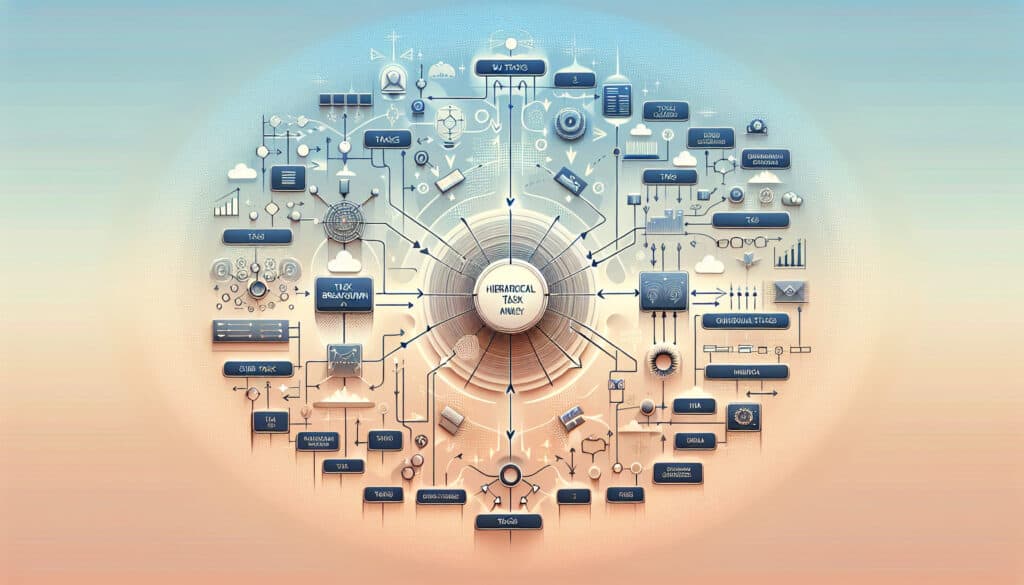To understand and describe how a task is performed.
- Metodologías: Clientes y marketing, Ideación, Diseño de producto
Hierarchical Task Analysis (HTA)

Hierarchical Task Analysis (HTA)
- Mejora continua, Pensamiento de diseño, Diseño centrado en el ser humano, Mejora de procesos, Capacitación, Usabilidad, Pruebas de usabilidad, Experiencia de usuario (UX), Interfaz de usuario (UI)
Objetivo:
Cómo se utiliza:
- A systematic method for breaking down a task into a hierarchy of goals, sub-goals, operations, and plans. It is used to understand the steps required to perform a task, identify potential problems, and design more efficient and user-friendly systems.
Ventajas
- Provides a detailed and structured understanding of a task; Helps to identify training needs and design better user interfaces.
Contras
- Can be time-consuming and complex to conduct; Requires a skilled analyst to perform correctly.
Categorías:
- Ergonomía, Diseño de producto
Ideal para:
- Analyzing complex tasks to improve user diseño de interfaz and develop effective training materials.
Hierarchical Task Analysis is particularly effective in industries such as software development, healthcare, and manufacturing, where complex tasks are commonly addressed through systematic evaluation. In software development, it aids in decomposing user interactions, guiding the design of intuitive interfaces, thereby improving user experience. In healthcare, HTA can clarify procedures involved in patient care, ensuring that medical personnel follow protocols efficiently, which is crucial for safety and compliance. Manufacturing processes benefit from HTA by identifying steps in assembly lines, enhancing productivity, and reducing errors. This methodology is typically initiated by product designers, engineers, and usability experts during the early stages of product development or redesign phases, leading to better collaboration among interdisciplinary teams. Participants might include subject matter experts, end-users, and instructional designers, who can provide valuable input on task execution and user experiences. The findings from HTA can inform training material development, ensuring that training corresponds with the actual tasks users will perform, which increases retention and competence in task execution. Through its structured approach, HTA allows teams to pinpoint potential failures in task execution, resulting in the design of systems that are not only efficient but also prioritize user-centric elements.
Pasos clave de esta metodología
- Define the main task that needs analysis.
- Break down the main task into sub-goals.
- Identify operations required to achieve each sub-goal.
- Develop plans detailing the execution of each operation.
- Create a visual representation of the hierarchy.
- Review and refine the hierarchy for clarity and completeness.
- Identify potential issues or inefficiencies within the hierarchy.
Consejos profesionales
- Incorporate user feedback early in the HTA process to refine goals and sub-goals, ensuring that the analysis reflects actual user behaviors and needs.
- Utilize task decomposition techniques like cognitive task analysis to explore user cognition and decision-making processes at each hierarchical level.
- Implement iterative testing of designs based on HTA findings to continuously improve usability and identify unforeseen challenges in real-world applications.
Leer y comparar varias metodologías, recomendamos el
> Amplio repositorio de metodologías <
junto con otras más de 400 metodologías.
Sus comentarios sobre esta metodología o información adicional son bienvenidos en la dirección sección de comentarios ↓ , así como cualquier idea o enlace relacionado con la ingeniería.
Contexto histórico
1986
(si se desconoce la fecha o no es relevante, por ejemplo "mecánica de fluidos", se ofrece una estimación redondeada de su notable aparición)

Publicaciones relacionadas
Gestión de operaciones de fabricación (MOM)
Sistema de Ejecución de Fabricación (MES)
Plan de control de la fabricación
Pruebas manuales
Tablas de evaluación de la manipulación manual (MAC)
ManTRA (Herramienta de evaluación de riesgos en las tareas manuales)